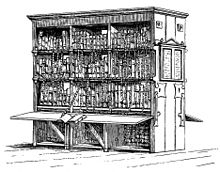
A chained library is a library where the books are attached to their bookcase by a chain, which is sufficiently long enough to allow the books to be taken from their shelves and read, but not removed from the library itself. The practice was usual for reference libraries (that is, the vast majority of libraries) from the Middle Ages to around the 18th century. This would prevent theft of the library's materials.[1] Since the chaining process was also expensive, it was not used on all books, only the more valuable books such as reference works or large books in a collection were chained.[2] Librarians in the Middle Ages often invoked curses as well to keep books from being stolen. Once such curse written into the books was,
Steal not this book my honest friend
For fear the gallows should be your end,
And when you die the Lord will say
And where's the book you stole away?[3]
It is standard for chained libraries to have the chain fitted to the corner or cover of a book. This is because if the chain were to be placed on the spine the book would suffer greater wear from the stress of moving it on and off the shelf. Because of the location of the chain attached to the book (via a ringlet) the books are housed with their spine facing away from the reader, with only the pages' fore-edges visible. This is so that each book can be removed and opened without needing to be turned around, hence avoiding tangling its chain. To remove the book from the chain, the librarian would use a key.[4][5]

The earliest example in England of a library to be endowed for use outside an institution such as a school or college was the Francis Trigge Chained Library in Grantham, Lincolnshire, established in 1598. The library still exists and can justifiably claim to be the forerunner of later public library systems. Marsh's Library in Dublin, built 1701, is another non-institutional library which is still housed in its original building. Here it was not the books that were chained, but rather the readers were locked into cages to prevent rare volumes from 'wandering'. There is also an example of a chained library in the Royal Grammar School, Guildford, as well as at Bolton School. Hereford Cathedral has the largest surviving chained library. While chaining books was a popular practice throughout Europe, it was not used in all libraries. The practice of chaining library books became less popular as printing increased and books became less expensive.[4] Wimborne Minster in Dorset, England is yet another example of a chained library. It is one of the first in England and the second (demoted to third after Wells Cathedral chained library re-chained a number of their books) largest.[6] It dates from 1868 and has 150 titles wrapped in lambs skin.[7] Another interesting example of a chained library is Florence's sixteenth-century Laurentian Library, designed by Michelangelo for Lorenzo de' Medici.[8]
Hereford Cathedral, in Hereford, England, has one of two chained libraries that still have chained books on its shelves.[9] The books in this library date mostly from the 12th century and are therefore handwritten as they predate the printing press.[7] The book pages were said to be made of cowhide, wood, leaves, clay, cloth, bark, metal, and unbleached animal skin, and was[clarification needed] written in the language of the people.[clarification needed] Under-privileged scholars settled for columns of text bounded between boards and papyrus. Papyrus was cheaper but could easily be destroyed and written over.[10]
In the Middle Ages, books were expensive and for the privileged, but they were highly valued. Books were the prime target for thieves and impoverished students to steal and sell. As a result, books were chained to shelves to preserve information.[10]
- ^ Weston, J. (10 May 2013). "The Last of the Great Chained Libraries".
- ^ Byrne, D. "Chained libraries". History Today, May 1987, 37, pp. 5–6.
- ^ Callas, Jennie E. (26 February 2010). "A Review of "The Library: An Illustrated History"". Internet Reference Services Quarterly. 15 (1): 69–70. doi:10.1080/10875300903535149. ISSN 1087-5301. S2CID 61069680.
- ^ a b Lopez, B. "New Chained Library of Hereford Cathedral Takes Royal Prize". American Libraries, 1997, p. 22.
- ^ "Chained Library". www.herefordcathedral.org. Retrieved 28 October 2022.
- ^ Ltd, Triple W Software. "Chained Library – Wimborne Minster". www.wimborneminster.org.uk. Retrieved 26 September 2015.
- ^ a b Meier, Allison (8 May 2014). "Reading in Restraint: The Last Chained Libraries". Atlas Obscura. Retrieved 27 October 2022.
- ^ Murray, Stuart P (2009). The Library An Illustrated History. New York, New York: Skyhorse Publishing. p. 82. ISBN 9781510733329.
- ^ Allison. "Reading in Restraint: The Last Chained Libraries". Atlas Obscura. 9.
- ^ a b Lyons, Martyn (2011). A Living History. Los Angeles. pp. 35–46.
{{cite book}}: CS1 maint: location missing publisher (link)
© MMXXIII Rich X Search. We shall prevail. All rights reserved. Rich X Search
